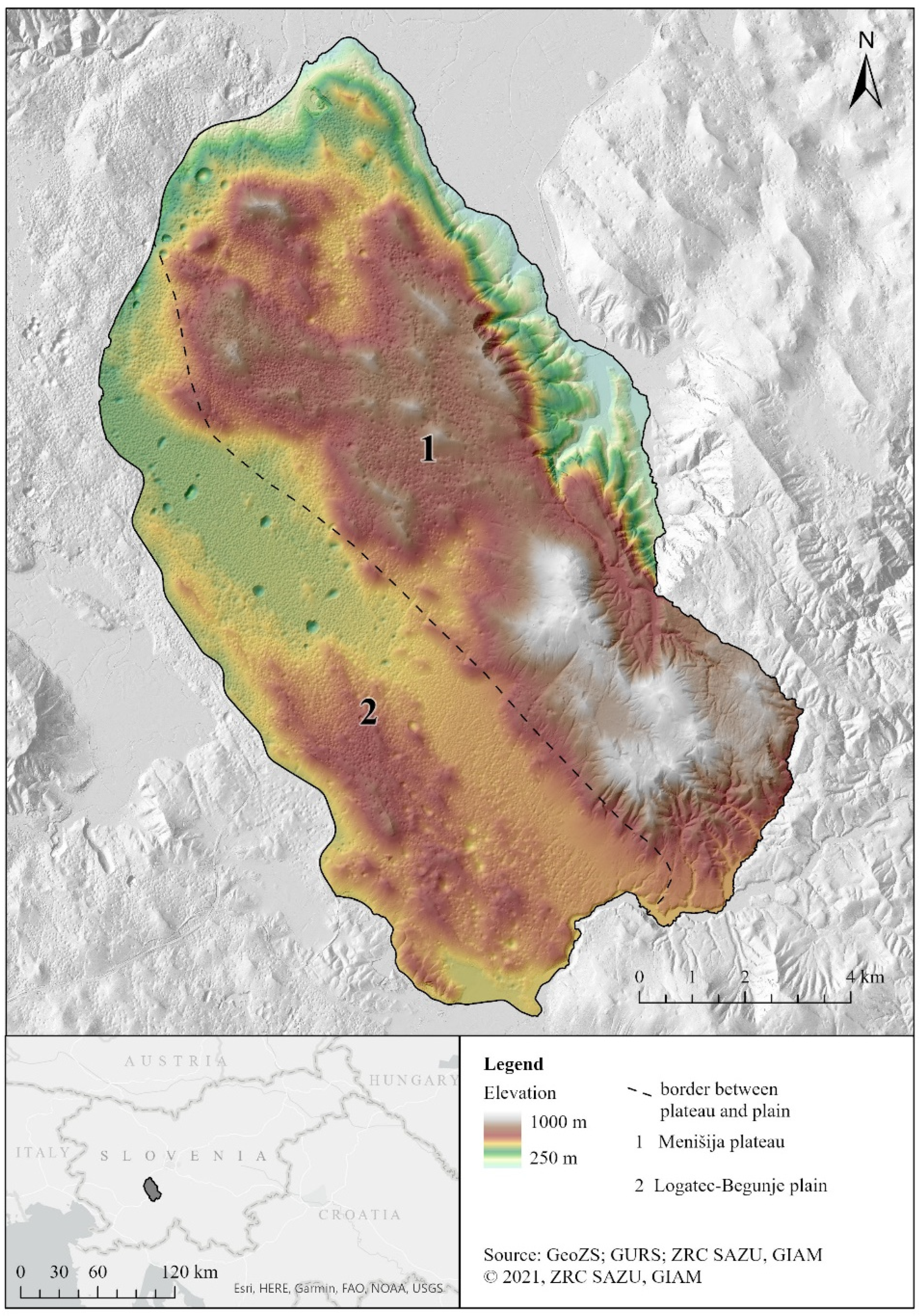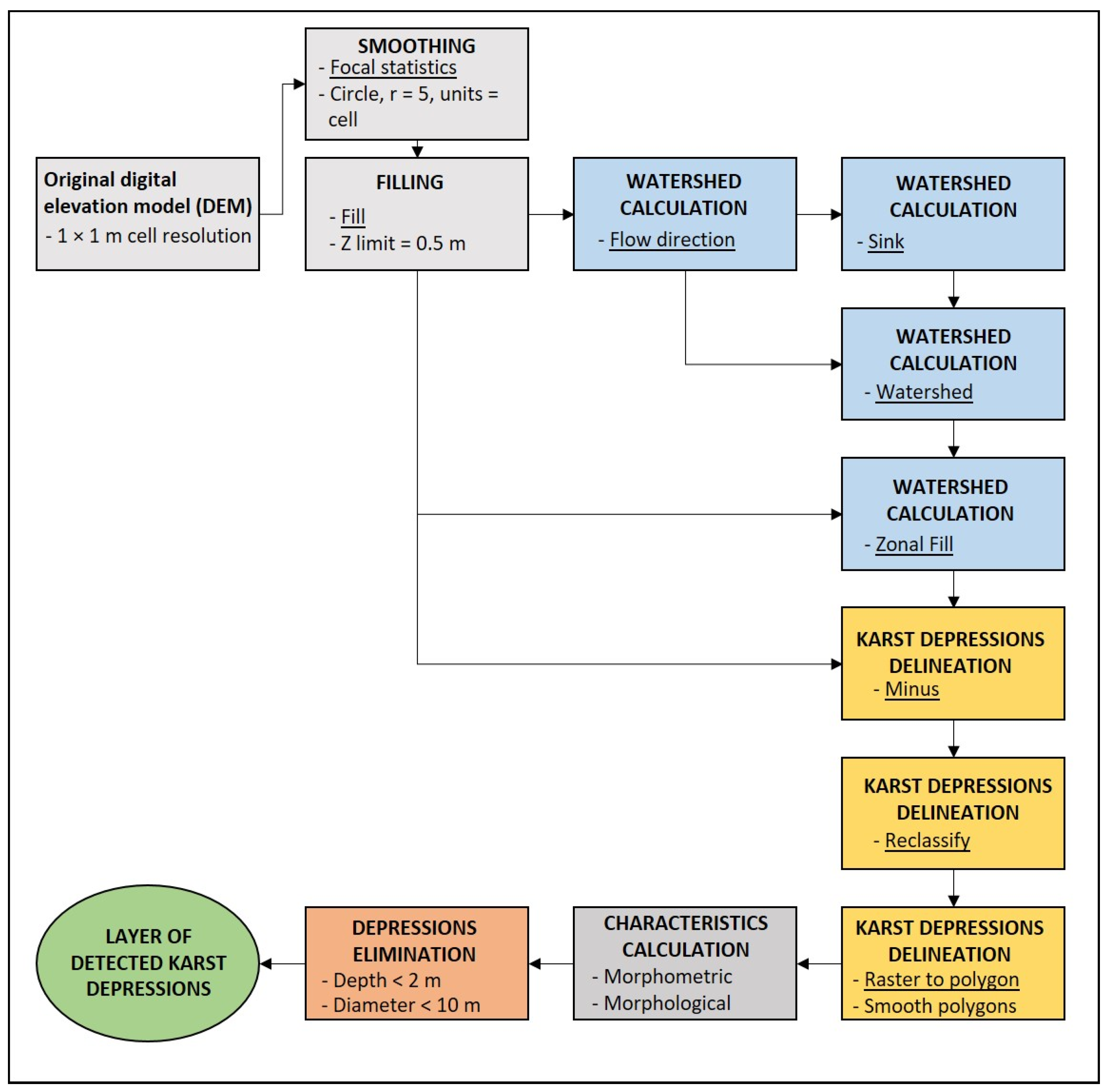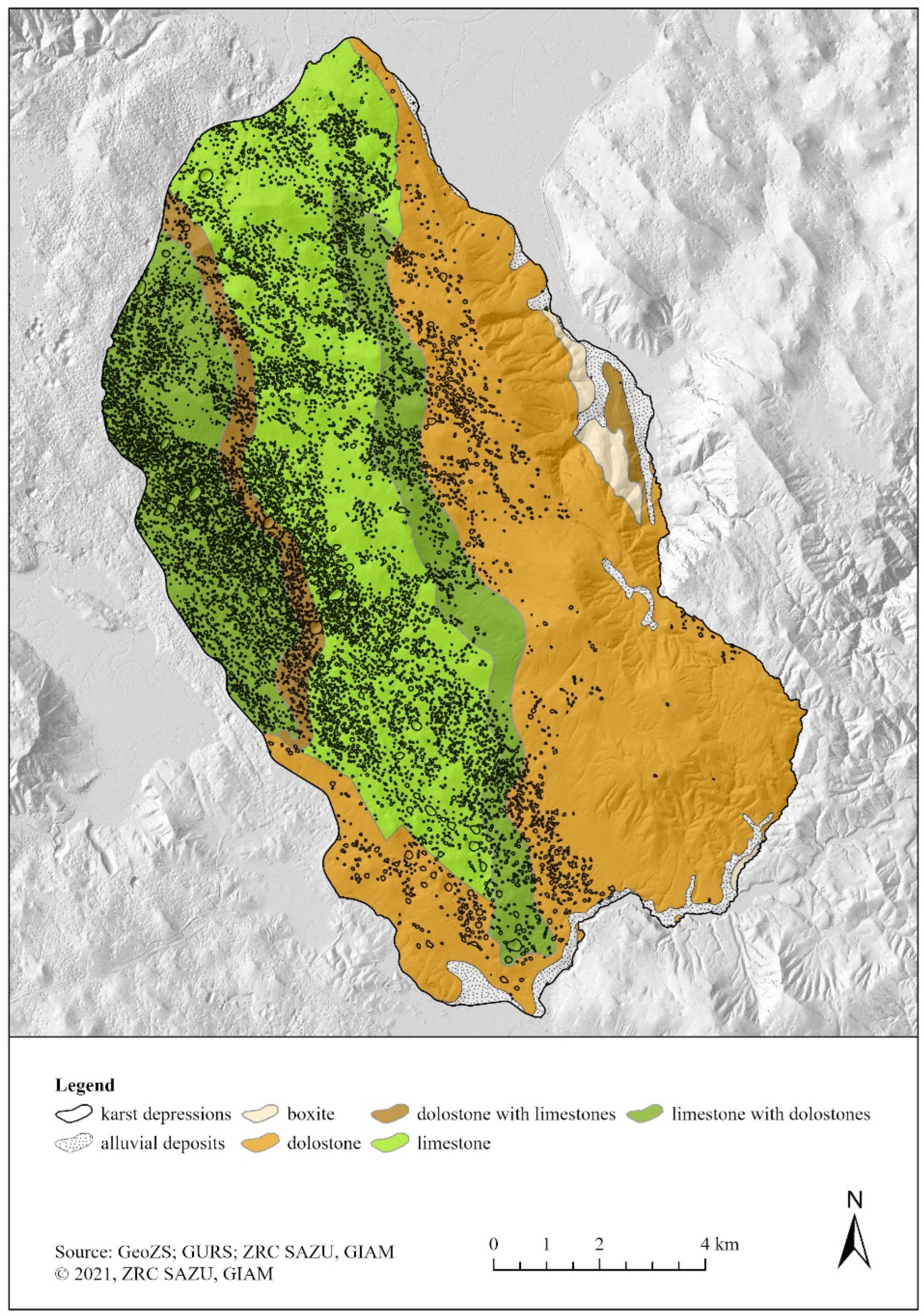Dolines and Cats: Remote Detection of Karst Depressions and Their Application to Study Wild Felid Ecology
Abstract
:1. Introduction
2. Material and Methods
2.1. Study Area
2.2. Detection of Karst Depressions
2.2.1. Calculation of Watersheds and Karst Depressions Delineation
2.2.2. Morphometric Characteristics and Size Criteria
2.2.3. Comparison of Automatic-Detection Method with Visual Recognition
2.3. Felid Space Use and Lynx Kill-Site Distribution in Respect to Karst Depressions
3. Results
3.1. Detection of Karst Depressions and Their Morphometric Characteristics
3.2. Comparison of Automatic-Detection Method with Visual Recognition
3.3. Felid Space Use and Lynx Kill-Site Distribution
4. Discussion
4.1. Remote Large-Scale Detection of Geomorphic Features
4.2. Selection of Karst Depressions by the Wild Felids
5. Conclusions
Supplementary Materials
Author Contributions
Funding
Institutional Review Board Statement
Informed Consent Statement
Data Availability Statement
Acknowledgments
Conflicts of Interest
References
- Tarolli, P.; Mudd, S.M. Introduction to Remote Sensing of Geomorphology. Dev. Earth Surf. Processes 2020, 23, xiii–xv. [Google Scholar] [CrossRef]
- Jensen, J.R. Remote Sensing of the Environment: An Earth Resource Perspective; Prentice-Hall International: Upper Saddle River, NJ, USA, 2000. [Google Scholar]
- Breg Valjavec, M.; Ciglič, R.; Oštir, K.; Ribeiro, D. Modelling habitats in karst landscape by integrating remote sensing and topography data. Open Geosci. 2018, 29, 137–156. [Google Scholar] [CrossRef]
- Weiss, A.D. Topographic position and landforms analysis; Poster Presentation. In Proceedings of the ESRI Users Conference, San Diego, CA, USA, 9–13 July 2001. [Google Scholar]
- Yokoyama, R.; Shirasawa, M.; Pike, R.J. Visualizing topography by openness: A new application of image processing to digital elevation models. Photogramm. Eng. Remote Sens. 2002, 68, 251–266. [Google Scholar]
- Zakšek, K.; Oštir, K.; Kokalj, Ž. Sky-View Factor as a Relief Visualization Technique. Remote Sens. 2011, 3, 398–415. [Google Scholar] [CrossRef] [Green Version]
- Drăguţ, L.; Eisank, C. Automated Object-Based Classification of Topography from SRTM Data. Geomorphology 2012, 141–142, 21–33. [Google Scholar] [CrossRef] [Green Version]
- Jasiewicz, J.; Stepinski, T.F. Geomorphons—A pattern recognition approach to classification and mapping of landforms. Geomorphology 2013, 182, 147–156. [Google Scholar] [CrossRef]
- Zhou, X.; Li, W.; Arundel, S.T. A spatio-contextual probabilistic model for extracting linear features in hilly terrains from high-resolution DEM data. Int. J. Geogr. Inf. Sci. 2018, 33, 666–686. [Google Scholar] [CrossRef]
- Syzdykbayev, M.; Karimi, B.; Karimi, H.A. A Method for Extracting Some Key Terrain Features from Shaded Relief of Digital Terrain Models. Remote Sens. 2020, 12, 2809. [Google Scholar] [CrossRef]
- Fernandez Diaz, J.C.; Carter, W.E.; Shrestha, R.L.; Glennie, C.L. Lidar Remote Sensing. In Handbook of Satellite Applications; Pelton, J.N., Madry, S., Camacho-Lara, S., Eds.; Springer: New York, NY, USA, 2013; pp. 757–808. [Google Scholar] [CrossRef]
- Höfle, B.; Rutzinger, M. Topographic Airborne Lidar in Geomorphology: A Technological Perspective. Z. Geomorphol. Suppl. Issues 2011, 55, 1–29. [Google Scholar] [CrossRef]
- Davis, B.A.; Asner, P.G. Advances in animal ecology from 3d-LiDAR ecosystem mapping. Trends Ecol. Evol. 2014, 29, 681–691. [Google Scholar] [CrossRef]
- Triglav Čekada, M. Možnost uporabe zračnega laserskega skeniranja (LIDAR) za geomorfološke študije. Geogr. Vestn. 2011, 83, 81–93. [Google Scholar]
- Telbisz, T.; Látos, T.; Deák, M.; Székely, B.; Koma, Z.; Standovár, T. The advantage of lidar digital terrain models in doline morphometry compared to topographic map based datasets—Aggtelek karst (Hungary) as an example. Acta Carsologica 2016, 45, 5–18. [Google Scholar] [CrossRef]
- Day, M.; Chenoweth, S. Surface Roughness of Karst Landscapes. In Treatise on Geomorphology; Shroder, F.J., Ed.; Academic Press: London, UK, 2013; pp. 157–163. [Google Scholar] [CrossRef]
- Gams, I. Kras v Sloveniji v Prostoru in Času, 2nd ed.; Založba ZRC: Ljubljana, Slovenija, 2004. [Google Scholar]
- Goldscheider, N.; Chen, Z.; Auler, A.S.; Bakalowicz, M.; Broda, S.; Drew, D.; Hartmann, J.; Jiang, G.; Moosdorf, N.; Stevanovic, Z.; et al. Global Distribution of Carbonate Rocks and Karst Water Resources. Hydrogeol. J. 2020, 28, 1661–1677. [Google Scholar] [CrossRef] [Green Version]
- Stepišnik, U. Fizična Geografija Krasa, 2nd ed.; Znanstvena založba Filozofske fakultete Univerze v Ljubljani: Ljubljana, Slovenia, 2020. [Google Scholar]
- Lipar, M.; Szymczak, P.; White, S.Q.; Webb, J.A. Solution Pipes and Focused Vertical Water Flow: Geomorphology and Modelling. Earth-Sci. Rev. 2021, 218, 103635. [Google Scholar] [CrossRef]
- Ford, D.C.; Williams, P.W. Karst Hydrogeology and Geomorphology, 1st ed.; John Wiley & Sons: Chichester, UK, 2008. [Google Scholar]
- Grlj, A. Omejevanje kraških kotanj z analizo polrezov. Dela 2020, 53, 5–22. [Google Scholar] [CrossRef]
- Doctor, D.; Young, J. An Evaluation of Automated GIS Tools for Delineating Karst Sinkholes and Closed Depressions from 1-Meter Lidar-Derived Digital Elevation Data. In Proceedings of the Thirteenth Multidisciplinary Conference on Sinkholes and the Engineering and Environmental Impacts of Karst, Carlsbad, NM, USA, 6–10 May 2013; pp. 449–458. [Google Scholar] [CrossRef] [Green Version]
- Veress, M. Karst Types and Their Karstification. J. Earth Sci. 2020, 31, 621–634. [Google Scholar] [CrossRef]
- Mihevc, A.; Mihevc, R. Morphological Characteristics and Distribution of Dolines in Slovenia, a Study of a Lidar-Based Doline Map of Slovenia. Acta Carsologica 2021, 50, 11–36. [Google Scholar] [CrossRef]
- Krofel, M. Winter observations of Eurasian Lynx (Lynx lynx) inspecting karst caves and dolines in the Northern Dinaric Mountains, Slovenia. Nat. Slov. Rev. Za Teren. Biol. 2010, 12, 65–67. [Google Scholar]
- Grlj, A.; Grigillo, D. Uporaba digitalnega modela višin in satelitskega posnetka RapidEye za zaznavanje kraških kotanj in brezstropih jam Podgorskega krasa. Dela 2014, 42, 129–147. [Google Scholar] [CrossRef]
- Kobal, M.; Bertoncelj, I.; Pirotti, F.; Dakskobler, I.; Kutnar, L. Using Lidar Data to Analyse Sinkhole Characteristics Relevant for Understory Vegetation under Forest Cover—Case Study of a High Karst Area in the Dinaric Mountains. PLoS ONE 2015, 10, e0122070. [Google Scholar] [CrossRef] [Green Version]
- Luo, Z.; Tang, S.; Jiang, Z.; Chen, J.; Fang, H.; Li, C. Conservation of Terrestrial Vertebrates in a Global Hotspot of Karst Area in Southwestern China. Sci. Rep. 2016, 6, 25717. [Google Scholar] [CrossRef] [PubMed] [Green Version]
- Breg Valjavec, M.; Zorn, M.; Čarni, A. Human-induced land degradation and biodiversity of Classical Karst landscape: On the example of enclosed karst depressions (dolines). Land Degrad. Dev. 2018, 29, 3823–3835. [Google Scholar] [CrossRef] [Green Version]
- Verbovšek, T.; Gabor, L. Morphometric properties of dolines in Matarsko podolje, SW Slovenia. Environ. Earth Sci. 2019, 78, 396. [Google Scholar] [CrossRef]
- Bátori, Z.; Vojtkó, A.; Keppel, G.; Tölgyesi, C.; Čarni, A.; Zorn, M.; Farkas, T.; Erdős, L.; Kiss, P.J.; Módra, G.; et al. Anthropogenic disturbances alter the conservation value of karst dolines. Biodivers. Conserv. 2020, 29, 503–525. [Google Scholar] [CrossRef] [Green Version]
- Obu, J.; Podobnikar, T. Algorithm for karst depression recognition using digital terrain models. Geod. Vestn. 2013, 57, 260–270. [Google Scholar] [CrossRef]
- Bauer, C. Analysis of dolines using multiple methods applied to airborne laser scanning data. Geomorphology 2015, 250, 78–88. [Google Scholar] [CrossRef]
- Wu, Q.; Deng, C.; Chen, Z. Automated delineation of karst sinkholes from LiDAR-derived digital elevation models. Geomorphology 2016, 266, 1–10. [Google Scholar] [CrossRef]
- Hofierka, J.; Gallay, M.; Bandura, P.; Šašak, J. Identification of Karst Sinkholes in a Forested Karst Landscape Using Airborne Laser Scanning Data and Water Flow Analysis. Geomorphology 2018, 308, 265–277. [Google Scholar] [CrossRef]
- Kim, Y.J.; Nam, B.H.; Youn, H. Sinkhole Detection and Characterization Using Lidar-Derived Dem with Logistic Regression. Remote Sens. 2019, 11, 1592. [Google Scholar] [CrossRef] [Green Version]
- Sappington, J.M.; Longshore, K.M.; Thompson, D.B. Quantifying Landscape Ruggedness for Animal Habitat Analysis: A Case Study Using Bighorn Sheep in the Mojave Desert. J. Wildl. Manag. 2007, 71, 1419–1426. [Google Scholar] [CrossRef]
- Bouchet, P.J.; Meeuwig, J.J.; Salgado Kent, C.P.; Letessier, T.B.; Jenner, C.K. Topographic Determinants of Mobile Vertebrate Predator Hotspots: Current Knowledge and Future Directions. Biol. Rev. 2014, 90, 699–728. [Google Scholar] [CrossRef] [PubMed]
- Ironside, K.E.; Mattson, D.J.; Arundel, T.; Theimer, T.; Holton, B.; Peters, M.; Edwards, C.T., Jr.; Hansen, J. Geomorphometry in Landscape Ecology: Issues of Scale, Physiography, and Application. Environ. Ecol. Res. 2018, 6, 397–412. [Google Scholar] [CrossRef]
- Oliveira, T.; Urra, F.; López-Martín, J.M.; Ballesteros-Duperón, E.; Barea-Azcón, J.M.; Moléon, M.; Gil-Sánchez, J.M.; Alves, P.C.; Díaz-Ruíz, F.; Ferreras, P.; et al. Females Know Better: Sex-Biased Habitat Selection by the European Wildcat. Ecol. Evol. 2018, 8, 9464–9477. [Google Scholar] [CrossRef] [PubMed]
- Cristescu, B.; Domokos, C.; Teichman, K.J.; Nielsen, S.E. Large Carnivore Habitat Suitability Modelling for Romania and Associated Predictions for Protected Areas. PeerJ 2019, 7, e6549. [Google Scholar] [CrossRef]
- Farhadinia, M.S.; Heit, D.R.; Montgomery, R.A.; Johnson, P.J.; Hobeali, K.; Hunter, L.T.; Macdonald, D.W. Vertical Relief Facilitates Spatial Segregation of a High Density Large Carnivore Population. Oikos 2019, 129, 346–355. [Google Scholar] [CrossRef]
- Krofel, M.; Potočnik, H.; Kos, I. Topographical and vegetational characteristics of lynx kill sites in Slovenian Dinaric mountains. Nat. Slov. Rev. Za Teren. Biol. 2007, 9, 25–36. [Google Scholar]
- Podgórski, T.; Schmidt, K.; Kowalczyk, R.; Gulczyńska, A. Microhabitat Selection by Eurasian Lynx and Its Implications for Species Conservation. Acta Theriol. 2008, 53, 97–110. [Google Scholar] [CrossRef]
- Dickson, B.G.; Beier, P. Quantifying the Influence of Topographic Position on Cougar (Puma Concolor) Movement in Southern California, USA. J. Zool. 2006, 271, 270–277. [Google Scholar] [CrossRef]
- Jerosch, S.; Götz, M.; Klar, N.; Roth, M. Characteristics of diurnal resting sites of the endangered European wildcat (Felis silvestris silvestris): Implications for its conservation. J. Nat. Conserv. 2010, 18, 45–54. [Google Scholar] [CrossRef]
- Belotti, E.; Červený, J.; Šustr, P.; Kreisinger, J.; Gaibani, G.; Bufka, L. Foraging Sites of Eurasian Lynxlynx Lynx: Relative Importance of Microhabitat and Prey Occurrence. Wildl. Biol. 2013, 19, 188–201. [Google Scholar] [CrossRef] [Green Version]
- Allen, M.L.; Hočevar, L.; de Groot, M.; Krofel, M. Where to Leave a Message? The Selection and Adaptive Significance of Scent-Marking Sites for Eurasian Lynx. Behav. Ecol. Sociobiol. 2017, 71, 136. [Google Scholar] [CrossRef]
- Jerosch, S.; Kramer-Schadt, S.; Götz, M.; Roth, M. The Importance of Small-Scale Structures in an Agriculturally Dominated Landscape for the European Wildcat (Felis Silvestris Silvestris) in Central Europe and Implications for Its Conservation. J. Nat. Conserv. 2018, 41, 88–96. [Google Scholar] [CrossRef]
- Signer, J.; Filla, M.; Schoneberg, S.; Kneib, T.; Bufka, L.; Belotti, E.; Heurich, M. Rocks Rock: The Importance of Rock Formations as Resting Sites of the Eurasian Lynx Lynx Lynx. Wildl. Biol. 2019, 2019, 1–5. [Google Scholar] [CrossRef] [Green Version]
- Hočevar, L.; Oliveira, T.; Krofel, M. Felid Bedrooms with a Panoramic View: Selection of Resting Sites by Eurasian Lynx (Lynx Lynx) in a Karstic Landscape. Behav. Ecol. Sociobiol. 2021, 75, 34. [Google Scholar] [CrossRef]
- Buser, S. Osnovna Geološka Karta SFRJ 1: 100.000, List Postojna; Zvezni Geološki Zavod: Beograd, Serbia, 1967. [Google Scholar]
- Pleničar, M. Osnovna Geološka Karta SFRJ 1: 100.000, Tolmač List Postojna; Zvezni Geološki Zavod: Beograd, Serbia, 1970. [Google Scholar]
- Habič, P. Vodna gladina v notranjskem in primorskem krasu Slovenije. Acta Carsologica 1985, 13, 37–78. [Google Scholar]
- Stepišnik, U. Udornice v Sloveniji; Znanstvena založba Filozofske fakultete: Ljubljana, Slovenia, 2010; 118p. [Google Scholar]
- Ogrin, D. Podnebni tipi v Sloveniji. Geogr. Vestn. 1996, 68, 39–56. [Google Scholar]
- Nadbath, M. Meteorološka postaja na Pokojišču. Naše Okolje Bilt. Agencije RS Za Okolje 2002, 19, 29–30. [Google Scholar]
- Perko, D.; Orožen Adamič, M. Slovenija—Pokrajine in Ljudje; Mladinska knjiga: Ljubljana, Slovenija, 2001. [Google Scholar]
- Kordiš, F. Dinarski Jelovo Bukovi Gozdovi v Sloveniji, 1st ed.; Univerza v Ljubljani, Biotehniška fakulteta, Oddelek za gozdarstvo in gozdna gospodarstva: Ljubljana, Slovenija, 1993. [Google Scholar]
- Krofel, M.; Huber, D.; Kos, I. Diet of Eurasian Lynx Lynx Lynx in the Northern Dinaric Mountains (Slovenia and Croatia). Acta Theriol. 2011, 56, 315–322. [Google Scholar] [CrossRef]
- Obu, J. Prepoznavanje Kraških Kotanj na Podlagi Digitalnega Modela Višin. Bachelor’s Thesis, Filozofska fakulteta Univerze v Ljubljani, Ljubljana, Slovenija, 2011. [Google Scholar]
- Triglav Čekada, M.; Bric, V. 2015: Končan je projekt laserskega skeniranja Slovenije/The project of laser scanning of Slovenia is completed. Geod. Vestn. 2015, 59, 586–592. [Google Scholar]
- LiDAR. Agencija RS za Okolje, Ministrstvo za Okolje in Prostor. 2015. Available online: http://gis.arso.gov.si/evode/profile.aspx?id=atlas_voda_Lidar@Arso (accessed on 23 December 2020).
- ArcGIS Pro. ESRI. 2021. Available online: https://www.esri.com/en-us/arcgis/products/arcgis-pro/overview (accessed on 4 August 2021).
- Krofel, M.; Skrbinšek, T.; Kos, I. Use of GPS Location Clusters Analysis to Study Predation, Feeding, and Maternal Behavior of the Eurasian Lynx. Ecol. Res. 2013, 28, 103–116. [Google Scholar] [CrossRef]
- Krofel, M.; Fležar, U.; Hočevar, L.; Sindičić, M.; Gomerčić, T.; Konec, M.; Slijepčević, V.; Bartol, M.; Boljte, B.; Črtalič, J.; et al. Surveillance of the Reinforcement Process of the Dinaric—SE Alpine Lynx Population in the Lynx-Monitoring Year 2019–2020; Technical Report; Biotechnical Faculty, University of Ljubljana: Ljubljana, Slovenia, 2021; p. 45. [Google Scholar]
- Johnson, D.H. The comparison of usage and availability measurements for evaluating resource preference. Ecology 1980, 61, 65–71. [Google Scholar] [CrossRef]
- Krofel, M.; Hočevar, L.; Allen, M.L. Does Human Infrastructure Shape Scent Marking in a Solitary Felid? Mamm. Biol. 2017, 87, 36–39. [Google Scholar] [CrossRef]
- Burnham, K.P.; Anderson, D.R. Advanced Issues and Deeper Insights. In Model Selection and Multimodel Inference; Burnham, K.P., Anderson, D.R., Eds.; Springer: New York, NY, USA, 2002. [Google Scholar] [CrossRef]
- Northrup, J.M.; Hooten, M.B.; Anderson, C.R.; Wittemyer, G. Practical Guidance on Characterizing Availability in Resource Selection Functions under a Use–Availability Design. Ecology 2013, 94, 1456–1463. [Google Scholar] [CrossRef] [PubMed]
- GPS Accuracy. Garmin. Available online: https://support.garmin.com/en-US/?faq=aZc8RezeAb9LjCDpJplTY7 (accessed on 6 December 2021).
- Bates, D.; Mächler, M.; Bolker, B.; Walker, S. Fitting Linear Mixed-Effects Models USINGLME4. J. Stat. Softw. 2015, 67, 1–48. [Google Scholar] [CrossRef]
- Šegina, E.; Benac, Č.; Rubinić, J.; Knez, M. Morphometric Analyses of Dolines—The Problem of Delineation and Calculation of Basic Parameters. Acta Carsologica 2018, 47, 23–33. [Google Scholar] [CrossRef]
- Petram, W.; Knauer, F.; Kaczensky, P. Human Influence on the Choice of Winter Dens by European Brown Bears in Slovenia. Biol. Conserv. 2004, 119, 129–136. [Google Scholar] [CrossRef]
- Mysterud, A.; Ims, R.A. Functional responses in habitat use: Availability influences relative use in trade-off situations. Ecology 1998, 79, 1125–1477. [Google Scholar] [CrossRef]
- Ripari, L.; Premier, J.; Belotti, E.; Bluhm, H.; Breitenmoser-Würsten, C.; Bufka, L.; Červený, J.; Drouet-Hoguet, N.; Fuxjäger, C.; Jędrzejewski, W.; et al. Human disturbance is the most limiting factor driving habitat selection of a large carnivore throughout Continental Europe. Biol. Conserv. 2022, 266, 109446. [Google Scholar] [CrossRef]
- Čonč, Š. Pomen varovanja vročih točk geodiverzitete za ohranitev biotske pestrosti na območju Nature 2000 v dolini reke Dragonje. Geogr. Vestn. 2020, 92, 9–28. [Google Scholar] [CrossRef]
- Gordon, J.E.; Bailey, J.J.; Larwood, J.G. Conserving nature’s stage provides a foundation for safeguarding both geodiversity and biodiversity in protected and conserved areas. Parks Steward. Forum 2022, 38, 46–55. [Google Scholar] [CrossRef]




| Area (m2) | Perimeter (m) | Diameter (m) | Depth (m) | Length (m) | Width (m) | Elevation (m) | |
|---|---|---|---|---|---|---|---|
| Study area (area = 137 km2, ndepressions = 9711) | |||||||
| Min | 102.4 | 37.8 | 11.4 | 2.0 | 6.2 | 5.0 | 299.9 |
| Max | 54,965.8 | 907.2 | 264.6 | 80.9 | 168.5 | 127.6 | 942.3 |
| Median ± IQR | 765.6 ± 713.6 | 102.6 ± 46.1 | 31.2 ± 14.0 | 3.6 ± 2.3 | 17.4 ± 8.0 | 14.0 ± 6.3 | 587.6 ± 98.8 |
| Ravnik (area = 52 km2, ndepressions = 5720, %depressions = 58.9%) | |||||||
| Min | 102.4 | 38.1 | 11.4 | 2.0 | 6.6 | 5.0 | 482.8 |
| Max | 54,965.8 | 907.2 | 264.6 | 80.9 | 168.5 | 127.6 | 697.6 |
| Median ± IQR | 788.8 ± 699.1 | 104.2 ± 44.7 | 31.7 ± 13.5 | 3.5 ± 2.2 | 17.6 ± 7.7 | 14.3 ± 6.2 | 554.8 ± 65.8 |
| Menišija (area = 85 km2, ndepressions = 3991, %depressions = 41.1%) | |||||||
| Min | 102.7 | 37.8 | 11.4 | 2.0 | 6.2 | 5.3 | 299.9 |
| Max | 48,146.5 | 794.8 | 247.6 | 68.0 | 132.4 | 115.8 | 942.3 |
| Median ± IQR | 722.9 ± 725.4 | 100.5 ± 47.7 | 30.3 ± 14.5 | 3.6 ± 2.4 | 17.1 ± 8.3 | 13.4 ± 6.6 | 642.1 ± 112.3 |
| Dataset | Model | k | AIC | ΔAIC | ρ | Model Coefficients | |
|---|---|---|---|---|---|---|---|
| Dist_Depressions [95% CI] | Dist_Roads [95% CI] | ||||||
| Lynx_GPS | Use ~ depressions + roads | 4 | 3241.6 | 0.0 | 0.9 | −0.8 [−0.9; −0.7] | −0.2 [−0.3; −0.1] |
| Null | 2 | 3374.6 | 133.0 | 0.5 | - | - | |
| Wildcat_GPS | Use ~ depressions + roads | 4 | 2818.2 | 0.0 | 0.4 | −0.7 [−1.2; −0.1] | 0.5 [0.34; 0.7] |
| Null | 2 | 2854.9 | 36.7 | 0.5 | - | - | |
| Lynx_kills | Use ~ depressions + roads | 4 | 155.5 | 0.0 | 0.3 | −0.1 [−0.3; 0.0] | −0.0 [−0.2; 0.1] |
| Null | 2 | 155.7 | 0.1 | 0.5 | - | - | |
Publisher’s Note: MDPI stays neutral with regard to jurisdictional claims in published maps and institutional affiliations. |
© 2022 by the authors. Licensee MDPI, Basel, Switzerland. This article is an open access article distributed under the terms and conditions of the Creative Commons Attribution (CC BY) license (https://creativecommons.org/licenses/by/4.0/).
Share and Cite
Čonč, Š.; Oliveira, T.; Portas, R.; Černe, R.; Breg Valjavec, M.; Krofel, M. Dolines and Cats: Remote Detection of Karst Depressions and Their Application to Study Wild Felid Ecology. Remote Sens. 2022, 14, 656. https://doi.org/10.3390/rs14030656
Čonč Š, Oliveira T, Portas R, Černe R, Breg Valjavec M, Krofel M. Dolines and Cats: Remote Detection of Karst Depressions and Their Application to Study Wild Felid Ecology. Remote Sensing. 2022; 14(3):656. https://doi.org/10.3390/rs14030656
Chicago/Turabian StyleČonč, Špela, Teresa Oliveira, Ruben Portas, Rok Černe, Mateja Breg Valjavec, and Miha Krofel. 2022. "Dolines and Cats: Remote Detection of Karst Depressions and Their Application to Study Wild Felid Ecology" Remote Sensing 14, no. 3: 656. https://doi.org/10.3390/rs14030656
APA StyleČonč, Š., Oliveira, T., Portas, R., Černe, R., Breg Valjavec, M., & Krofel, M. (2022). Dolines and Cats: Remote Detection of Karst Depressions and Their Application to Study Wild Felid Ecology. Remote Sensing, 14(3), 656. https://doi.org/10.3390/rs14030656







